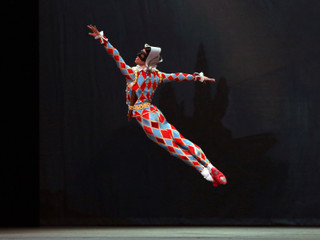|
Back
200 x $ 5,000 = Un million Orange County
Segerstrom Hall
01/17/2019 - & January 18, 19, 20, 2019
Harlequinade (Les Millions d’Arlequin)
Alexei Ratmansky after Marius Petipa (Choreography), Riccardo Drigo (Music)
James Whiteside/Carlos Gonzales/Daniil Simkin*/Tyler Maloney (Harlequinade), Isabella Boylston/Sarah Lane/Skylar Brandt*/Cassandra Trenary (Columbine), Stella Abrera*/Misty Copeland/Hee Seo/Christine Shevchenko (Pierrette), Thomas Forster* (Pierrot), Alexandre Hammoudi/Blaine Hoven/Calvin Royal III (Pierrot, Harlequin’s friends), Alexei Agoudine (Cassandre), Duncan Lyle (Léandre), Tatiana Ratmansky (good fairy), Alexandra Basmagy/ Zhong-Jing Fang/Catherine Hurlin/Katherine Williams/Joseph Gorak/Jose Sebastian (Harlequin’s friends), Aran Bell/Patrick Frenette/Simon Hoke/Kento Sumitani (Cassandre’s henchmen), Marshall Whiteley (officer), Luigi Crispino/Jonathan Klein/Cameron McCune/Garegin Pogossian/Javier Rivet/Nathan Vendt (soldiers), Connor Holloway/Tyler Maloney (Léandre’s lackeys), Kathryn Boren/April Giangeruso/Courtney Lavine/Virginia Lensi/Fengqi Li/Isadora Loyola/Betsy McBride/Lauren Post/Wanyue Qiao/Rachel Richarson/Stephanie Williams/Remy Young (larks), American Ballet Theatre (ABT) corps de ballet, ABT William J. Gillespie School dancers
Pacific Symphony, Ormsby Wilkins (conductor)
Alexei Ratmansky (artistic director and choreographer), Robert Perdziola (set and costume designer), Brad Fields (lighting designer)

J. Whiteside (© Rosalie O’Connor)
ABT’s no stranger to Orange County. Artist in Residence, Alexei Ratmansky has not only spearheaded such classics as last month’s The Nutcraker, but he’s also gifted esoteric productions, such as Richard Strauss’ confectioned Schlagobers in 2017 and now the rare, comical jewel, Harlequinade.
This production, 18 months in the making, was meticulously vetted by M. Ratmansky, in keeping with distinguished protocols formatted by Premier maître de ballet Marius Petipa. Such scrutinization easily spilled over to Robert Perdziola’s orbite extravagante with such a festive color palette that it was easy to delineate the Commedia dell’arte’s social stratums and cast members. The significance of the ballet’s original name, Les Millions d’Arlequin, can be taken in the most literal sense since M. Perdziola’s punctilious dress requisites on average cost $ 5,000 USD apiece with approximately 200 dancers slipping into the pricey garbs...voilà!...a million dollar delight!
Such lavishness doesn’t stop there for the music is a treasure trove of ebullient passages: some quaint, some snappy, some downright silly...that credit goes to Riccardo Drigo. Even though he’s not a great household name (at least inside The United States), his firm placement in the ballet repertoire is significant since five years prior to Harlequinade’s premiere (1900), the Italian re-worked Tchaikovsky’s Swan Lake into what is now the definitive version performed world-wide...such stature deserves a stronger look.
As earlier noted, Harlequinade’s ingredients contain a frivolous spread of Commedia dell’arte stock characters dished out in a heavy batter of pantomime that rise and puff in Act I. Non-dance rôles of Alexei Agoudine’s irascible Cassandre got overwrought in contrast to Duncan Lyle’s foppish Léandre which added a gentler strain of humor.

S. Lane (© Erin Baiano)
Opening night's indisposed leads, Isabella Boylston and James Whiteside, permitted Skylar Brandt and Daniil Simkin being spotlighted as the perky Columbine and the overconfident zanni, Harlequin, respectively. The “Sérénade” found Mlle Brandt tentative, at times, in her movement; however, during Act II’s pas de deux her confidence revived with an en pointe performance of impeccable grace. Daniil Simkin’s gesticulations and trademark cabriolets neatly aligned within the stereotypical Harlequinade that kept the entire ballet on a predominately even keel.

S. Abrera (© Erin Baiano)
The evening, however, belonged to Stella Abrera and her coquettish portrayal of Pierrette. She “multi-tasked”, having to deal with her simpleminded husband, Pierrot, while expressing her more “approachable” dance side and flittering discourses with other members. Mlle Abrera’s sprite remarks suggest the lightest of nuanced proportions, along with an added asterisk to each of her allonges. Wrapped up inside a white billowy cloth with bright red shoes, Thomas Forster made the best of what he had to wear. An over-hyped clown, the conundrum dealt with his flailing hands while gaping inside wide sleeves that got in the way [of others] and excessively spun out of control, appearing overtly tedious.
With a sudden puff of smoke, the Good Fairy (Tatiana Ratmansky) popped out of a pseudo-marble niche to assist Harlequin’s romantic needs. M. Perdziola’s assigned dress for the benevolent spirit seemed out-of-period (especially while Mlle Ratmansky wore a glittering Chopard necklace), suggesting, rather, she strayed from a Hello Dolly! set.
The various pas immediately beginning Act II were a veritable “layer upon layer” feast for the eyes. Entering the ballroom (ref: “Polonaise”), the retinue of guests attending Harlequin’s and Columbine’s wedding was a mélange of wildly ranged hues and textures, though the magic of the dance moved on splendidly well into the Grand divertissement under Ormsby Wilkins’ watch. Pacific Symphony ran through Drigo’s score on a thin bullet and a sharp tightrope which intensified the ballet’s sublime trimmings, particularly during the pizzicatti pas and the “Sérénade.”
It may be on the short "bucket list” for ballet tomfoolery, and ABT succeeded in spawning a grand amusement with a broad vision. Harlequinade is like a pâtesserie soufflé: it rises to the occasion with heavy frosting of sprinkled sparkles…it’s worth a million bucks!
Christie Grimstad
|